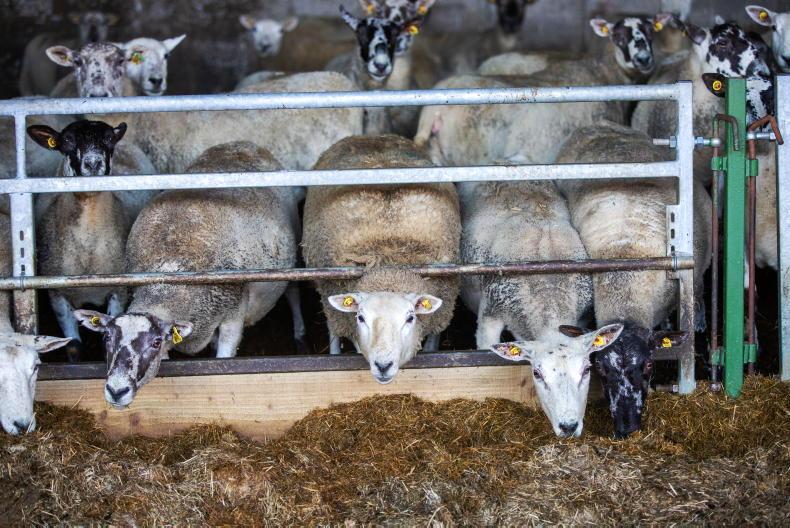Housing is taking place this week on highly stocked farms, with grass reserves depleting quickly in recent weeks.
Where ewes can be housed dry, it allow ewes to settle quicker into their new environment and for those carrying out winter shearing, it will make this task much more straightforward.
Decisions on winter shearing have been questioned more in recent years due to wool prices being on the floor and not even being capable of making a significant contribution to shearing costs.
However, there are numerous production benefits to winter shearing that knock the hard edge off costs borne.
Increased lamb birth weight
Teagasc research shows winter shearing has the potential to increase lamb birth weight in mid-season lambing ewes by 0.6kg without increasing lambing difficulty.
This in turn feeds into an increase in weaning weight by 1.9kg liveweight and subsequently reduces the age of lambs to slaughter by about two weeks.
Winter shearing allows about 15% more ewes to be housed in a given space. This is advantageous, provided there is sufficient feeding space for all ewes to eat unrestricted.
Shearing will also allow condition to be monitored easier and keep ewes cleaner pre- and post-lambing.
Advantages
Longer term, it has advantages in keeping ewes cleaner at grass in early lactation and in reducing the risk of ewes getting caught on their backs.
Take note that ewes should only be shorn where there is the potential for at least eight weeks wool regrowth and ewes are being turned outdoors from March onwards.

Ewes should only be shorn where there is potential for at least eight weeks wool regrowth and where sheep will not be turned outdoors until early to mid-March onwards. \ Philip Doyle
Shearing is not recommended where ewes will be turned outdoors earlier, as there is a greater risk of a sustained period of lower temperatures, while there should also be good shelter available should weather conditions turn bad post-turnout.
Winter shearing lambs
Research in Athenry has shown that shearing lambs will deliver no benefits in terms of lamb performance, but it is a great aid in keeping lambs cleaner, while also allowing more animals to be housed in a given area.
Research has also shown that four weeks wool regrowth will typically be required before slaughter to be in a position to clip lambs again if needed to comply with the clean livestock policy. This advice applies to lowland and hill breeds.
Housing is taking place this week on highly stocked farms, with grass reserves depleting quickly in recent weeks.
Where ewes can be housed dry, it allow ewes to settle quicker into their new environment and for those carrying out winter shearing, it will make this task much more straightforward.
Decisions on winter shearing have been questioned more in recent years due to wool prices being on the floor and not even being capable of making a significant contribution to shearing costs.
However, there are numerous production benefits to winter shearing that knock the hard edge off costs borne.
Increased lamb birth weight
Teagasc research shows winter shearing has the potential to increase lamb birth weight in mid-season lambing ewes by 0.6kg without increasing lambing difficulty.
This in turn feeds into an increase in weaning weight by 1.9kg liveweight and subsequently reduces the age of lambs to slaughter by about two weeks.
Winter shearing allows about 15% more ewes to be housed in a given space. This is advantageous, provided there is sufficient feeding space for all ewes to eat unrestricted.
Shearing will also allow condition to be monitored easier and keep ewes cleaner pre- and post-lambing.
Advantages
Longer term, it has advantages in keeping ewes cleaner at grass in early lactation and in reducing the risk of ewes getting caught on their backs.
Take note that ewes should only be shorn where there is the potential for at least eight weeks wool regrowth and ewes are being turned outdoors from March onwards.

Ewes should only be shorn where there is potential for at least eight weeks wool regrowth and where sheep will not be turned outdoors until early to mid-March onwards. \ Philip Doyle
Shearing is not recommended where ewes will be turned outdoors earlier, as there is a greater risk of a sustained period of lower temperatures, while there should also be good shelter available should weather conditions turn bad post-turnout.
Winter shearing lambs
Research in Athenry has shown that shearing lambs will deliver no benefits in terms of lamb performance, but it is a great aid in keeping lambs cleaner, while also allowing more animals to be housed in a given area.
Research has also shown that four weeks wool regrowth will typically be required before slaughter to be in a position to clip lambs again if needed to comply with the clean livestock policy. This advice applies to lowland and hill breeds.







 This is a subscriber-only article
This is a subscriber-only article











SHARING OPTIONS: